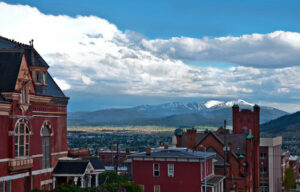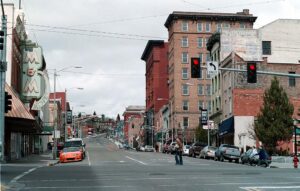Known as America’s Mining City and The Richest Hill on Earth, Butte is chock full of historical wonders. One of the most interesting is Butte’s Berkeley Pit. Located at the east end of Park Street in uptown Butte, many folks come from near and far to view this former copper mine. It’s certainly hard to miss– Berkeley Pit sits one mile long by half a mile wide.
Once home to a bustling open-pit mining operation, Berkeley Pit is now a nearly 1,800-foot deep crater filled with various heavy metals and “unique microscopic lifeforms.” The more than 40 billion liquid gallons in this pit include acidic water, copper, iron, arsenic, zinc, sulfuric acid and more. The water level as of January 2021 sits just over 5,356 feet above sea level. Keep up with the latest levels at PitWatch.org.

Berkeley Pit’s Lifespan
Berkeley Pit operated for 27 years from 1955 through 1982. At the time, open-pit mining was deemed much safer than underground mining for the miners. During the time of its operations, only six fatalities were recorded at Berkeley Pit– significantly less than most other mining facilities.
According to Colorado State University’s Department of Biology, about one billion tons of material were mined from the Berkeley Pit. In addition to copper, other extracted metals included silver and gold. It was this operation that gave Butte its nickname, The Richest Hill on Earth.

Superfund Site
The Berkeley Pit is a Federal Superfund Environmental Clean-up Site and is part of the largest complex of Superfund sites in the United States. Congress established the Comprehensive Environmental Response, Compensation and Liability Act (CERCLA) in 1980, which is informally known as Superfund. Under this act, the United States Environmental Protection Agency (EPA) can clean up contaminated sites.
Berkeley Pit officially closed in 1982 after the site was abandoned. Because of this, the underground pumps were turned off. This led to the return of groundwater filling the pit. “Due to the nature of the Butte ore, and a century of underground and surface mining that exposed that ore to air and water, the water filling the Berkeley Pit is highly acidic and contaminated” with a variety of toxic heavy metals.
According to the EPA, “several cleanup actions have been completed to address immediate health threats over the last 20 years.”

Research & Job Opportunities
While this colorful waste pit may not sound appealing to an outsider, this Superfund site actually brings about an incredible host of research opportunities. Scientists still actively research this site. In fact, Montana Tech professors and scientists, Andrea and Don Stierle are working to isolate compounds from the pit’s microbes.
This husband and wife team have found such compounds may be used to save lives. “We realized that the compounds they made in that particular environment are the kinds of things that we might be able to use as drugs for our [human] toxic environments, which are cancer and inflammation,” Don Stierle said in an interview.
It’s incredible what can be found in the most extreme environments– especially one right in our backyard! Today, the site offers a viewing platform for curious visitors hoping to catch a glimpse.




